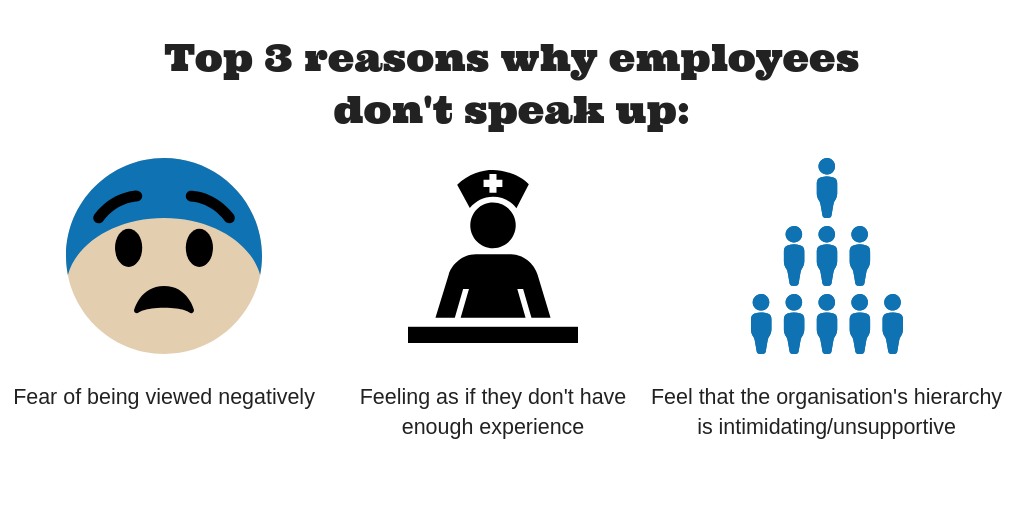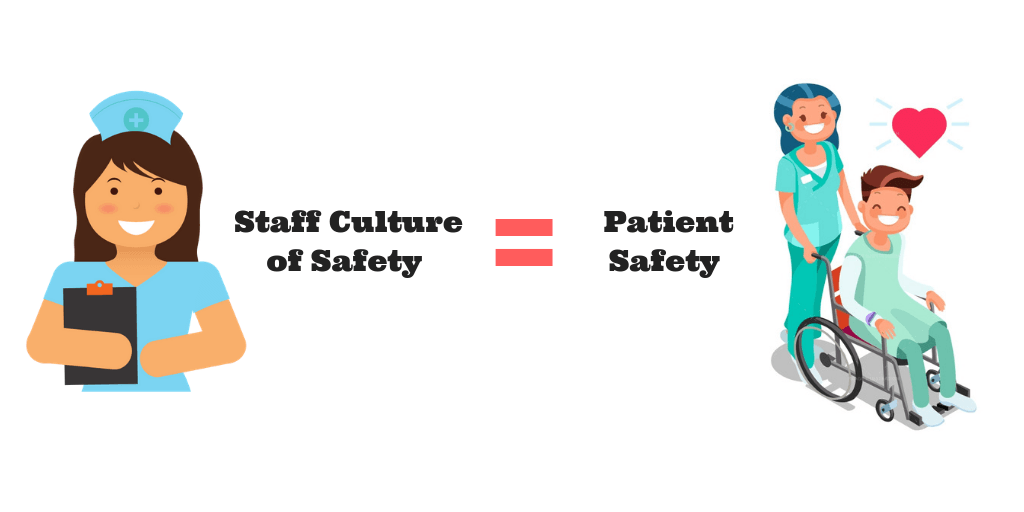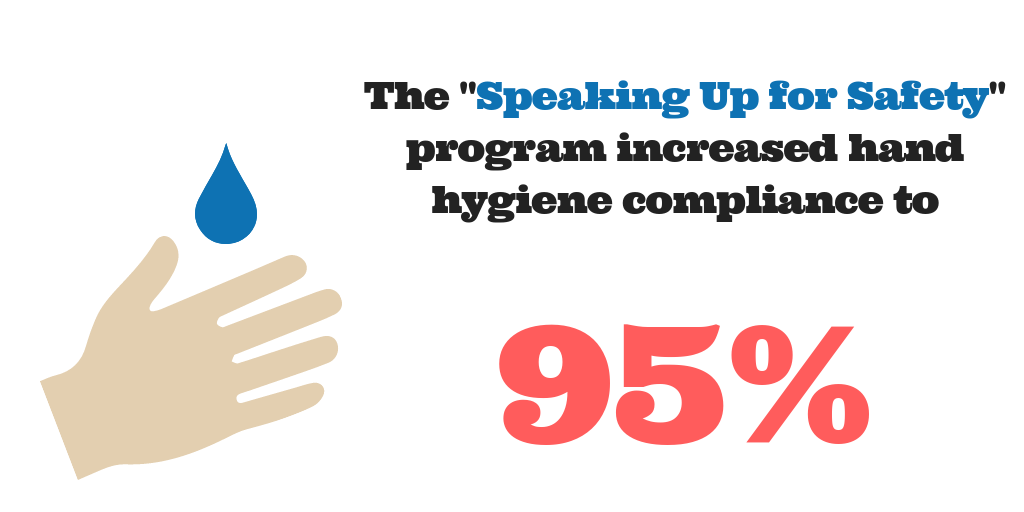Silence Isn’t “Safe”. Speaking Up Is.
No matter their position or speciality, most medical and nursing professionals have had some experience in hesitating with speaking up when they see a safety risk. Even when the medical professional is fully aware of the potential hazard to the patient, staying silent can be seen as a “safe” option. In a large-scale study, 50% of nurses described situations where they should have spoken up, yet only 10% of the time did they voice their concerns.
What Is Speaking Up?
Safety concerns that require speaking up about include:
- Mistakes such as missed diagnoses
- Violating hygiene protocol
- Rule breaking
- Medication errors
- Administration errors
- Patient management decisions such as delayed transfer to intensive care unit
- Outdated safety protocols
Why Speaking Up Doesn’t Occur
If not speaking up can cause patient’s harm, then why do people stay silent? The answer is not quite straight-forward.
Whether an individual speaks up or not is influenced by a number of factors; personal (such as age or personality), organisational (such as position in hierarchy), and contextual (such as the organisation’s policies and safety culture). It is suggested that the contextual factors are the primary motive for employees staying silent. In a qualitative study undertaken in the US, the top three reasons that employees didn’t speak up about their concerns or problems were out of fear of being viewed negatively, feeling as if they did not have enough experience or tenure to speak up, and considering their organization to have an intimidating hierarchical structure and/or an unsupportive climate.
How an organisation responds to their staff speaking up is also a factor. Some nurses feel that raising concerns is a high-risk, low-benefit action, as nurses who speak up may be viewed as someone who wasn’t a “team-player”, and staff members who commit unsafe actions don’t receive any consequences.
Why Speaking Up Is Critical to Patient Safety:
When medical professionals are speaking up about safety concerns, the hospital, clinic, or other healthcare institution are able to detect, correct, and prevent unsafe work practices and complications during patients’ stay.
Staying silent has deeply negative effects including interfering with employees’ psychological safety, decreasing teamwork among units, increasing employee turnover, ceasing opportunities to learn and improve, increasing costs, and ultimately increasing risks to patients.
Speaking up is essential to the safety climate of a healthcare organisation, which has been shown to be a crucial aspect for patient safety. Speaking up comes under advocacy for the patient, which is a moral obligation of nurses under The American Nurses Association (ANA) Code of Ethics.
Therefore, healthcare organisations are obligated to encourage a culture of safety that values staff input. To achieve this, the organisation should both encourage and empower speaking up in staff of all positions, and reinforce their commitment by responding to voiced concerns adequately. Tolerating unsafe and disrespectful behaviours will make it impossible for healthcare organisations to cultivate the norms and values necessary to provide safe, and efficient care for the patient, and a joyful work environment for the staff.
Case Study- John Hopkins Medicine:
After finding that one of their physicians had engaged in serious misconduct, John Hopkins Medicine (JHM) sought to improve employee voice by commissing a team of evaluators from Cambridge University to review the attitudes of Senior leadership and front-line staff regarding speaking up.
The evaluators stated that “the first step, of course, is gaining knowledge of the problems. The second is doing something about them.”
During the interview phase in 2014, JHM were made aware of the barriers staff faced when speaking up. These were:
- The system for reporting concerns was convoluted and confusing
- Staff were worried about hostile responses from those senior or being labelled a “bad team player”
- The “untouchables”; often senior physicians who engaged in poor conduct but did not face consequences
The result was a culture of fear where staff members felt there were negative responses to speaking up, and that nothing would be done about those who acted poorly.
JHM leaders implemented interventions from 2014-2016 to address the concerns of staff and encourage speaking up. This included sharing the interview findings with senior leadership, co-ordinating reporting systems, training leadership on how to handle difficult conversations, and ensuring that unacceptable behaviours had considerable consequences.
In addition, the “Safe at Hopkins” program was enforced to promote a culture of safety through prevention and early intervention in unprofessional and disruptive behaviours which was designed to provide psychological safety to those who were speaking up, and those who were reported.
The interventions had a positive impact on staff at John Hopkins. During the study period, employees made 382 individual reports of disruptive behaviour that led to 55 investigations, in which officials interviewed an entire clinical unit.
Most of the reported individuals were referred and provided with additional support. Nine of the reported individuals were eventually removed from their positions of power.
Case Study- Arkansas Children’s Hospital:
Arkansas Children Hospital realised that their staff was not practising Hand Hygiene to an acceptable level. In February 2012, members of the infection prevention program formed the hand hygiene improvement team. The final project goal was to improve hand hygiene compliance to ≥ 95% by July 2014, and to find the strategies that would best achieve this goal.
The baseline hand hygiene compliance was 75%. Initial interventions followed WHO’s advice and included education on hand hygiene, a leadership commitment, reminder signs, hygiene supplies being readily available, and sharing data with staff. This increased hand hygiene compliance to an average of 82%.
Following these steps, a “Speaking Up For Safety” program was implemented across the hospital. The program became the ultimate error prevention tool as it trained staff on how to speak up to those who weren’t complying with hand hygiene practices, and set up a chain of command for reporting if resistance was found. The staff were given a “script” for how to discuss hand hygiene with their colleagues; “ask, request, concern”.
- Ask: Did you perform hand hygiene?
- Request: Can I offer you some hand gel?
- Concern: I have a concern that you are not performing hand hygiene
If a staff member was concerned that someone was still refusing to comply, the local nursing director would speak with them personally. Reporting events were documented and tracked on cards, which were also used as raffle tickets. Incentivising speaking up, and setting up consequences for non-compliance cultivated a culture within the hospital, and increased hand-hygiene compliance to a sustained 95%.
Recommendations
To encourage healthcare workers to speak up, leaders should start to cultivate a culture of safety and open communication. Some recommended ways to begin this are by:
- Talking to staff frequently and positively about speaking up,
- Reviewing the chain of command policies so that all staff know their options if facing resistance to their objections,
- Conducting role playing activities to explore how to Handle difficult conversations,
- Share the stories of situations where speaking up protected patients or stories where remaining silent was a factor in patient harm, and
- Providing clear support for clinical staff in all serious events
References:
- Okuyama, A. et al. (2014). “Speaking up for patient safety by hospital-based health care professionals: a literature review”. BMC Health Services Research, 14:61. http://www.ncbi.nlm.nih.gov/pmc/articles/PMC4016383/
- Rainer, J. (2015). “Speaking up: factors and issues in nurses advocating for patients when patients are in jeopardy.” Journal of Nursing Care Quality, 1:53-62. http://www.ncbi.nlm.nih.gov/pubmed/25084469
- Schwappach, D et al. (2018). “Speak up-related climate and its association with healthcare workers’ speaking up and withholding voice behaviours: a cross-sectional survey in Switzerland”. BMJ Quality Safety. http://qualitysafety.bmj.com/content/early/2018/03/22/bmjqs-2017-007388
- Manapragada, A et al. (2016). “Staying silent about safety issues: Conceptualizing and measuring safety silence motives”. Accident Analysis & Prevention, 1:91. http://www-sciencedirect-com.ezproxy.library.uq.edu.au/science/article/pii/S0001457516300471
- Katz-Navon, T et al. (2005). “Safety Climate in Health Care Organizations: A Multidimensional Approach”. The Academy of Management Journal, 48:6. http://www.jstor.org/stable/20159730?seq=1#page_scan_tab_contents
- Dixon-Woods, M et al. (2018). “Improving Employee Voice About Transgressive or Disruptive Behavior: A Case Study”. Academic Medicine. http://journals.lww.com/academicmedicine/Abstract/publishahead/Improving_Employee_Voice_About_Transgressive_or.97812.aspx
- Linam, W et al. (2017). “Impact of a Successful Speaking Up Program on Health-Care Worker Hand Hygiene Behaviour”. Paediatric Quality and Safety, 2:4. http://journals.lww.com/pqs/Fulltext/2017/07000/Impact_of_a_Successful_Speaking_Up_Program_on.6.aspx





Do not lose focus of what your job expectations are.